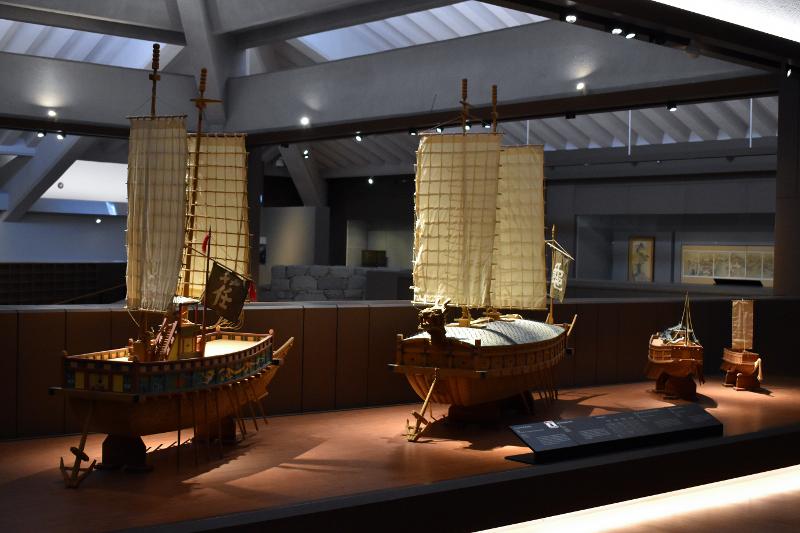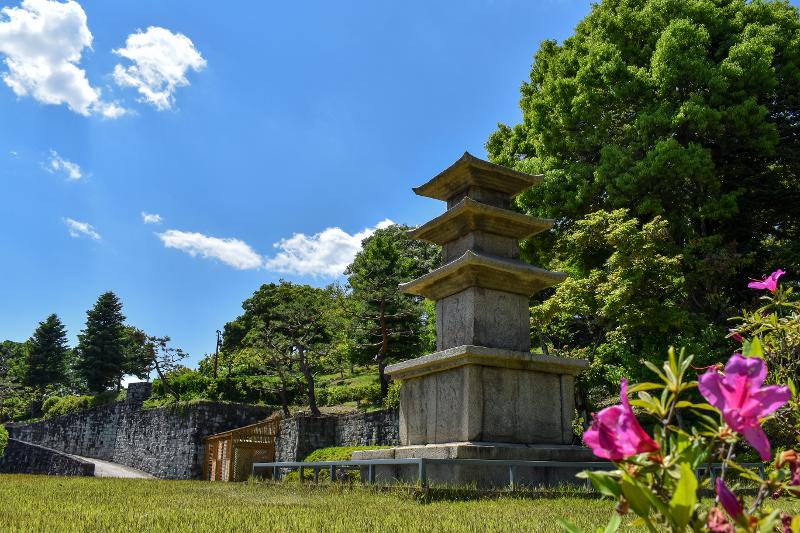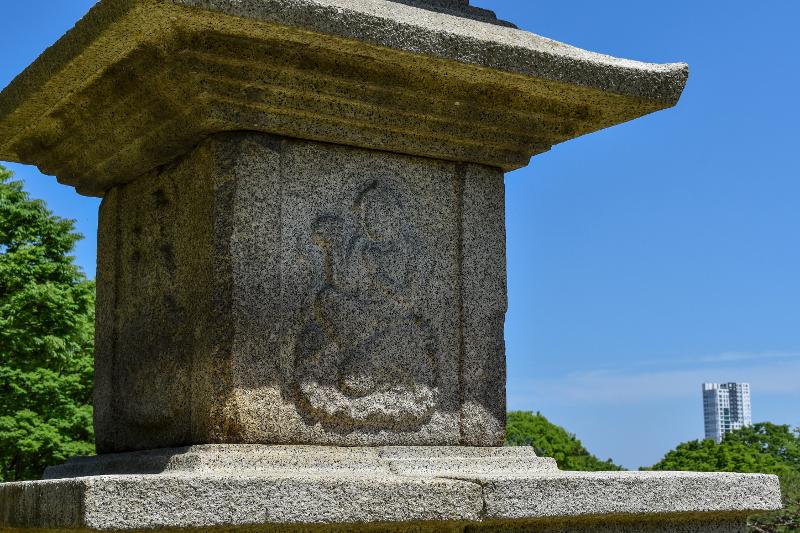Information Center
- Main page
- Information Center
- Government News
Government News
- Date
- 2024.05.20
A museum is where a country's history and culture live and breathe and the past, present and future coexist, as well as showing the nation's cultural power. Korea.net has selected six national museums by region to introduce leading must-see works displayed at each. The fifth installment of this series focuses on Jinju National Museum in Jinju, Gyeongsangnam-do Province, the nation's only museum focused on the Imjin Waeran, or Japan's invasions of the Korean Peninsula in the late 16th century, that offers a detailed look at the background, process and results of the conflict. |

On the left is a replica of a panokseon (sailing and rowing vessel) and on the right is one of a geobukseon (turtle ship) at Imjin Waeran Hall of Jinju National Museum. (Choi Jin-woo)
By Margareth Theresia and Choi Jin-woo
1. Joongwangu: Joseon Dynasty's representative cannon |

With a diameter of 27.1 cm and length of 64 cm, the mid-size cannon joongwangu (second from right), aka a medium mortar shooting thunderclap bomb shell or stone cannonball, was used during the Imjin Waeran, or Japanese invasions of the Korean Peninsula in the late 16th century. (Choi Jin-woo)
The Imjin Waeran was a series of late 16-century Japanese invasions of the Korean Peninsula from 1592-98. The second invasion from 1597-98 is also called the Jeongyu Waeran.
The conflict involved the Joseon Dynasty, Japan and China's Ming Dynasty and significantly impacted their societies, economies and cultures. Traces of the war are found at Imjin Waeran Hall of Jinju National Museum in Jinju, Gyeongsangnam-do Province, with the weaponry used standing out.
The first eye-catching item at the hall is artillery used at the time, namely the joongwangu (mid-size cannon) that was primarily used to attack or defend castles from the early to late Joseon eras. The one displayed at the museum was found during excavations of Jeonggaesan Mountain Fortress in Hadong-gun County, Gyeongsangnam-do.
A wangu is a type of cannon made during the Joseon era classified into four types based on size: large, medium, small and very small. Unlike typical cylindrical cannons, this weapon has a bowl-shaped chamber up front for loading a projectile with an effective range of 350-500 steps (400-500 m). Its inscription says it was made in 1590 by Lee Mul-geum at Sangjupo during the Joseon Dynasty, indicating a system of naming the maker in artillery production.
"The joongwangu was used for a long time from the early to late Joseon period, but only two have survived," the museum's associate curator Choi Yumi said. "Among them, the cannon at Jinju National Museum is particularly important because its inscription shows the date of manufacture and maker's name."
2. Nat'l treasure showing province's Buddhist art: Three-story Stone Pagoda in Beomhak-ri, Sancheong |

The Three-story Stone Pagoda in the village of Beomhak-ri in Sancheong-gun County, Gyeongsangnam-do Province, represents Buddhist art in the province in the outdoor exhibition area next to Jinju National Museum. (Choi Jin-woo)
A stone tower in the outdoor exhibition area next to the museum appears striking even from a distance. With a height of 4.42 m, the Three-story Stone Pagoda in Beomhak-ri (Village), Sancheong (a county in Gyeongsangnam-do) has sharply raised corners on the edges of the eaves both lively and sharp, showcasing the excellence of Buddhist art in the province.
The pagoda shows a typical structure with a three-story pagoda on top of a two-tier pedestal, a characteristic typical of Unified Silla style. Unfortunately, the decoration at the top and the stones covering the lower pedestal cover are missing. This relic is also the country's lone one of its kind made from syenite.
This tower got its nickname "decorative pagoda" from its intricately carved eight guardians and bodhisattva statues on the pedestal and first-level body. While it lacks the grandeur and simplicity of expression found in more ornate designs, this relic is still considered an excellent representation of stone pagodas from the late Unified Silla era.
 The bodhisattva statue on the west side of the first-story pagoda body holds a lotus flower in her right hand and has her left placed in front of her chest. Her bent fingers are uniquely shaped. (Choi Jin-woo)
The bodhisattva statue on the west side of the first-story pagoda body holds a lotus flower in her right hand and has her left placed in front of her chest. Her bent fingers are uniquely shaped. (Choi Jin-woo)
Eight deity statues are carved into one side of the upper-tier pedestal, with two on each side. Perhaps these statues are guardians who protect Buddhism with their power, with those carved on the pagoda wearing armor and wielding weapons.
"All four sides of the first level of the pagoda have carvings of bodhisattva statues making offerings, but just the one in front faces forward," Choi said. "The combination of deity and bodhisattva statues is a unique example and important indicator of the stone pagoda style of ninth-century Unified Silla, showcasing the exceptional carving techniques and high-level Buddhist art of that era"
3. Carrier of dead souls: Pottery Vessel with Chariot Wheels |

The work Pottery Vessel with Chariot Wheels is 21.6 cm tall and 23.3 cm long and whose base has a diameter of 11.5 cm. Its base is wide at the bottom and tapers upwards, with a horn-shaped vessel on top. (Jinju National Museum)
This horn-shaped vessel is from the fifth century in the Ara Gaya region in the vicinity of present-day Haman-gun County, Gyeongsangnam-do. Back then, both the Silla and Gaya kingdoms made patterned earthenware shaped like things including carts, houses, animals and shoes.
The style used was known as petroglyphic pottery, whose items are mainly excavated from tombs. For this reason, the vessel is believed to be related to the actions or procedures of the deceased and associated individuals.
The vessel appears to have used to drink beverages like alcohol during rituals and symbolizing the transportation of the dead's soul to the afterlife. Unlike other horn-shaped vessels, its distinctive feature is its decorations shaped like cart wheels and ferns, and this makes it a key relic offering insight into the rituals of the Gaya people.
# More ways to enjoy Jinju National Museum Jinju National Museum produces content not only on displayed artifacts but also to help visitors better understand the Imjin Waeran. The museum's immersive experience hall presents "A Great Victory Sparked by the Seungja-Chongtong" in Korean, English, Chinese and Japanese for all visitors -- Korean or foreign. Make reservations to see this on the museum's website (https://jinju.museum.go.kr/eng/). The hall uses extended reality to offer the experience of Korea's first C-type reloadable cannon Seungja-Chongtong. Visitors can also pretend to man the weapon and take part in the historical events Great Battle of Hansan and First Jinjuseong Battle of the Imjin Waeran to gain a deeper understanding of the conflict. Watch content on the Imjin Waeran through videos like "Firepower Joseon Series" on the museum's official YouTube channel (https://www.youtube.com/playlist?list=PL1qQ3tmkDHhQM1I5QdKobPWG1aV0i6HeJ) with subtitles in English, Chinese and other languages. More for foreign visitors are planned. |
margareth@korea.kr